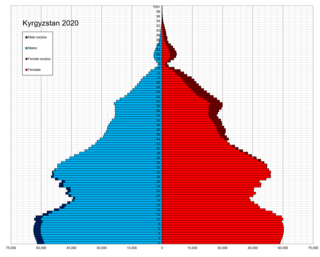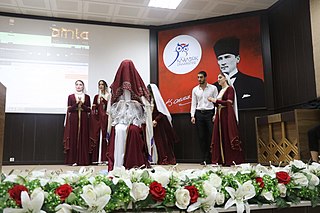Related Research Articles

The Demographics of Kyrgyzstan is about the demographic features of the population of Kyrgyzstan, including population growth, population density, ethnicity, education level, health, economic status, religious affiliations, and other aspects of the population. The name Kyrgyz, both for the people and the country, means "forty tribes", a reference to the epic hero Manas who unified forty tribes against the Oirats, as symbolized by the 40-ray sun on the flag of Kyrgyzstan.

Meskhetian Turks, also referred to as Turkish Meskhetians, Ahiska Turks, and Turkish Ahiskans, are a subgroup of ethnic Turkish people formerly inhabiting the Meskheti region of Georgia, along the border with Turkey. The Turkish presence in Meskheti began with the Ottoman military expedition of 1578, although Turkic tribes had settled in the region as early as the eleventh and twelfth centuries.

The Karakalpak Autonomous Soviet Socialist Republic, also known as Soviet Karakalpakstan or simply Karakalpakstan, was an autonomous republic within the Soviet Union. Until 20 July 1932, it was called the Karakalpak Autonomous Oblast. On 5 December 1936, it was moved from the Russian SFSR to the Uzbek SSR. It was the only ASSR in Soviet Central Asia.

Saint Petersburg is the second largest city in Russia, after Moscow and the fourth most populous city in Europe.

The Turkish population refers to the number of ethnic Turkish people in the world. During the Seljuk (1037–1194) and Ottoman (1299–1923) eras, ethnic Turks were settled across the lands conquered by the two empires. In particular, the Turkification of Anatolia was the result of the Battle of Manzikert in 1071 and the formation of the Sultanate of Rum. Thereafter, the Ottomans continued Turkish expansion throughout the regions around the Black Sea and the Mediterranean Sea. Consequently, today the Turkish people form a majority in Turkey and Northern Cyprus. There are also significant Turkish minorities who still live in the Balkans, the Caucasus, the Middle East and the Levant, and North Africa.
Turks in Ukraine are people of Turkish ethnicity living in Ukraine. The first Turkish settlement started during the Ottoman rule of Ukraine. In addition, there has been modern migration to the country largely formed of Meskhetian Turks, followed by immigrants from Turkey and Turkish communities from other post-Ottoman territories, such as Turkish Cypriots from Northern Cyprus.
Turks in Russia, also referred to as Turkish Russians or Russian Turks, refers to people of full or partial ethnic Turkish origin who have either immigrated to Russia or who were born in the Russian state. The community is largely made up of several migration waves, including: descendants of Ottoman-Turkish captives during the Russo-Turkish wars; the Turkish Meskhetian community; and the more recent Turkish immigrants from the Republic of Turkey.

Turks in Kazakhstan are ethnic Turks who live in Kazakhstan, mostly from Meskheti after the Deportation of the Meskhetian Turks.
Turks in Uzbekistan are ethnic Turks who live in Uzbekistan.

The Kurds in Azerbaijan form a part of the historically significant Kurdish population in the post-Soviet space. Kurds established a presence in the Caucasus with the establishment of the Kurdish Shaddadid dynasty in the 10th and 11th centuries. Some Kurdish tribes were recorded in Karabakh by the end of the sixteenth century. However, virtually the entire contemporary Kurdish population in the modern Azerbaijan descends from migrants from 19th-century Qajar Iran.

The Circassian diaspora are ethnic Circassian people around the world who live outside their homeland Circassia. The majority of the Circassians live in the diaspora, as their ancestors were settled during the resettlement of the Circassian population, especially during the late nineteenth and early twentieth century. From 1763 to 1864, the Circassians fought against the Russian Empire in the Russian-Circassian War, finally succumbing to a scorched-earth genocide campaign initiated between 1862 and 1864. Afterwards, large numbers of Circassians were exiled and deported to the Ottoman Empire and other nearby regions; others were resettled in Russia far from their home territories. Circassians live in more than fifty countries, besides the Republic of Adygea. Total population estimates differ: according to some sources, some two million live in Turkey, Jordan, Syria, and Iraq; other sources say between one and four million live in Turkey alone.
Ingiloys are an ethnographic subgroup of Georgians who speak the Ingiloy dialect of Georgian. Ingiloys are indigenous to Saingilo, a cultural and historical region located in the northwest of present-day Azerbaijan.

Russians are the second-largest ethnic minority in Azerbaijan, and the country is home to the largest Russian community in the South Caucasus and one of the largest outside of Russia. Although in decline, the community still numbers 71,000 people as of 2019. Since their arrival at the beginning of the 19th century, the Russians have played an important role in all spheres of life, particularly during the Czarist and Soviet period, especially in the capital city of Baku.

The Kurds in Georgia form a major part of the historically significant Kurdish population in the post-Soviet space, and are members of the eponymous ethnic group that are citizens of Georgia. In the 20th century, most Kurds fled religious persecution in the Ottoman Empire to the Russian Empire. The return of their Kurdish surnames needs effort according to a Kurdish activist in Georgia. The Kurds also have their own schools, school books and a printing press in Georgia. Illiteracy among them disappeared in the early 1900s. Kurds in Georgia are politically neutral; however, in 1999 they staged a huge demonstration in Tbilisi, demanding the release of the founder of the Kurdistan Workers' Party, Abdullah Öcalan. Kurds in Georgia today use Cyrillic script. Earlier, in the 1920s, they used the Latin script.
Armenians in the Baltic states of Estonia, Latvia, and Lithuania settled there mostly during the Soviet occupation of the Baltic States, although some of the first settlers arrived during the Russian Empire's rule in the Baltics.

Kurds in Russia form a major part of the historically significant Kurdish population in the post-Soviet space, with close ties to the Kurdish communities in the Caucasus and Central Asia.

The Kurds in Turkmenistan form a part of the historically significant Kurdish population in the post-Soviet space, and encompass people born in or residing in Turkmenistan who are of Kurdish origin. In the 17th century, Abbas I of Persia and Nader Shah settled Kurdish tribes from Khuzestan alongside the Iranian-Turkmen border. More Kurds arrived to Turkmenistan in the 19th century to find unclaimed land and to escape starvation.
Azerbaijanis in Kazakhstan are part of the greater Azerbaijani diaspora. They are Kazakh citizens and permanent residents of ethnic Azerbaijani background. According to the 2009 census, there were 85,292 ethnic Azerbaijanis living in Kazakhstan; Azerbaijanis comprised 0.5% of Kazakhstan's population and were the country's tenth-largest ethnic minority.
Tatars in Azerbaijan are Azerbaijani citizens and people of Tatar origin. According to the 2009 census, 25,882 Tatars live in the Republic of Azerbaijan. This is 0.29% of the total population.

The deportation of the Meskhetian Turks was the forced transfer by the Soviet government of the entire Meskhetian Turk population from the Meskheti region of the Georgian Soviet Socialist Republic to Central Asia on 14 November 1944. During the deportation, between 92,307 and 94,955 Meskhetian Turks were forcibly removed from 212 villages. They were packed into cattle wagons and mostly sent to the Uzbek Soviet Socialist Republic. Members of other ethnic groups were also deported during the operation, including Kurds and Hemshins, bringing the total to approximately 115,000 evicted people. They were placed in special settlements where they were assigned to forced labor. The deportation and harsh conditions in exile caused between 12,589 to 50,000 deaths.
References
- ↑ Donaldson 1981 , 311.
- ↑ Cornell 2001 , 182.
- ↑ Cornell 2001 , 183.
- ↑ Cornell 2001 , 183.
- ↑ Rywkin 1994 , 67.
- ↑ Ther & Siljak 2001 , 4.
- ↑ Bennigsen & Broxup 1983 , 30.
- ↑ Cohen & Deng 1998 , 263.
- ↑ Schnabel & Carment 2004 , 63.
- ↑ Drobizheva, Gottemoeller & Kelleher 1998 , 296.
- ↑ Khazanov 1995 , 202.
- ↑ Babak, Vaisman & Wasserman 2004 , 253.
- ↑ Демоскоп Weekly. "Первая всеобщая перепись населения Российской Империи 1897 г. Распределение населения по родному языку, губерниям и областям" . Retrieved 2009-11-10.
- ↑ Rywkin 1994 , 67.
- ↑ Демоскоп Weekly. "Всесоюзная перепись населения 1970 года. Национальный состав населения по республикам СССР" . Retrieved 2009-11-10.
- ↑ Демоскоп Weekly. "Всесоюзная перепись населения 1979 года. Национальный состав населения по республикам СССР" . Retrieved 2009-11-10.
- ↑ Демоскоп Weekly. "Всесоюзная перепись населения 1989 года. Национальный состав населения по республикам СССР" . Retrieved 2009-11-10.
- 1 2 3 4 Aydıngün et al. 2006 , 13.
- ↑ Blacklock 2005 , 7.
- ↑ Blacklock 2005 , 10.
- 1 2 3 Aydıngün et al. 2006 , 14.
- ↑ Blacklock 2005 , 8.